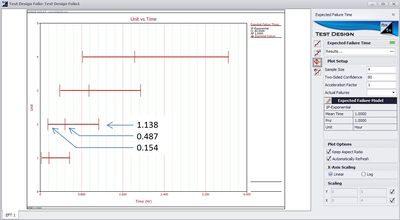Template:Test Design Using Expected Failure Time Plots: Difference between revisions
No edit summary |
No edit summary |
||
| Line 4: | Line 4: | ||
One of the new features in Weibull++ 8 is the Expected Failure Time Calculation (EFTC) tool. Given the population size and the failure time distribution \(F\left(t\right))\), the EFTC tool estimates the expected value of the nth failure and its confidence interval at any confidence level. | One of the new features in Weibull++ 8 is the Expected Failure Time Calculation (EFTC) tool. Given the population size and the failure time distribution \(F\left(t\right))\), the EFTC tool estimates the expected value of the nth failure and its confidence interval at any confidence level. | ||
The EFTC tool works by first calculating the probability of failure ''F'' as a function of the sample size ''n'' and number of failures ''r''. This function is given by the equation <math> f\left(n,r,CL\right)=\frac{1}{1+\frac{n-r+1}{rF_{2r,2\left(n-r+1\right),1-CL}}} </math> where ''CL'' is the confidence level. For example, given ''n'' = 4, ''r'' = 2 and ''CL'' = 0.5, the median rank for ''F'' is <math> f\left(4,2,0.5\right)=\frac{1}{1+\frac{4-2+1}{2F_{4,2\left(3\right),0.5}}}=0.385728 </math> The 80% 2-sided confidence interval on the probability of failure F is bounded by <math> f\left(4,2,0.1\right)=\frac{1}{1+\frac{4-2+1}{2F_{4,2\left(3\right),0.9}}}=0.142559 </math> and <math> f\left(4,2,0.9\right)=\frac{1}{1+\frac{4-2+1}{2F_{4,2\left(3\right),0.1}}}=0.679539 </math> With the probabilities of failure known, and assuming the failure distribution is exponentially distributed with parameter \(\lambda\,\!\) = 1, the expected times to failure can be calculated. For example, the median time to the second failure is calculated as <math> t=-\frac{ln\left(1-F\right)}{\lambda}=-\frac{1-0.385728}{1}=0.48732 </math> Similarly, the 10th percentile and 90th percentiles of time to failure are calculated as <math> t=-\frac{1-0.142559}{1}=0.153803 | The EFTC tool works by first calculating the probability of failure ''F'' as a function of the sample size ''n'' and number of failures ''r''. This function is given by the equation <math> f\left(n,r,CL\right)=\frac{1}{1+\frac{n-r+1}{rF_{2r,2\left(n-r+1\right),1-CL}}} </math> where ''CL'' is the confidence level. For example, given ''n'' = 4, ''r'' = 2 and ''CL'' = 0.5, the median rank for ''F'' is <math> f\left(4,2,0.5\right)=\frac{1}{1+\frac{4-2+1}{2F_{4,2\left(3\right),0.5}}}=0.385728 </math> The 80% 2-sided confidence interval on the probability of failure F is bounded by <math> f\left(4,2,0.1\right)=\frac{1}{1+\frac{4-2+1}{2F_{4,2\left(3\right),0.9}}}=0.142559 </math> and <math> f\left(4,2,0.9\right)=\frac{1}{1+\frac{4-2+1}{2F_{4,2\left(3\right),0.1}}}=0.679539 </math> With the probabilities of failure known, and assuming the failure distribution is exponentially distributed with parameter \(\lambda\,\!\) = 1, the expected times to failure can be calculated. For example, the median time to the second failure is calculated as <math> t=-\frac{ln\left(1-F\right)}{\lambda}=-\frac{1-0.385728}{1}=0.48732 </math> Similarly, the 10th percentile and 90th percentiles of time to failure are calculated as <math> t=-\frac{1-0.142559}{1}=0.153803 </math> and <math> t=-\frac{1-0.679539}{1}=1.137995 </math> The above results can also be seen in Weibull++ as shown below. | ||
[[Image:Eftc2.jpg|thumb|center|400px| ]] | [[Image:Eftc2.jpg|thumb|center|400px| ]] | ||
Revision as of 18:16, 15 August 2011
One of the new features in Weibull++ 8 is the Expected Failure Time Calculation (EFTC) tool. Given the population size and the failure time distribution \(F\left(t\right))\), the EFTC tool estimates the expected value of the nth failure and its confidence interval at any confidence level.
The EFTC tool works by first calculating the probability of failure F as a function of the sample size n and number of failures r. This function is given by the equation [math]\displaystyle{ f\left(n,r,CL\right)=\frac{1}{1+\frac{n-r+1}{rF_{2r,2\left(n-r+1\right),1-CL}}} }[/math] where CL is the confidence level. For example, given n = 4, r = 2 and CL = 0.5, the median rank for F is [math]\displaystyle{ f\left(4,2,0.5\right)=\frac{1}{1+\frac{4-2+1}{2F_{4,2\left(3\right),0.5}}}=0.385728 }[/math] The 80% 2-sided confidence interval on the probability of failure F is bounded by [math]\displaystyle{ f\left(4,2,0.1\right)=\frac{1}{1+\frac{4-2+1}{2F_{4,2\left(3\right),0.9}}}=0.142559 }[/math] and [math]\displaystyle{ f\left(4,2,0.9\right)=\frac{1}{1+\frac{4-2+1}{2F_{4,2\left(3\right),0.1}}}=0.679539 }[/math] With the probabilities of failure known, and assuming the failure distribution is exponentially distributed with parameter \(\lambda\,\!\) = 1, the expected times to failure can be calculated. For example, the median time to the second failure is calculated as [math]\displaystyle{ t=-\frac{ln\left(1-F\right)}{\lambda}=-\frac{1-0.385728}{1}=0.48732 }[/math] Similarly, the 10th percentile and 90th percentiles of time to failure are calculated as [math]\displaystyle{ t=-\frac{1-0.142559}{1}=0.153803 }[/math] and [math]\displaystyle{ t=-\frac{1-0.679539}{1}=1.137995 }[/math] The above results can also be seen in Weibull++ as shown below.

